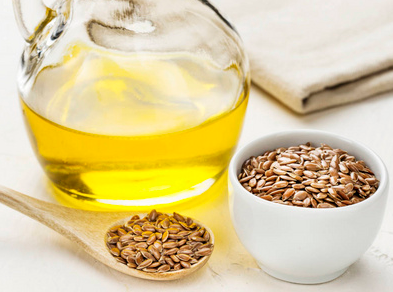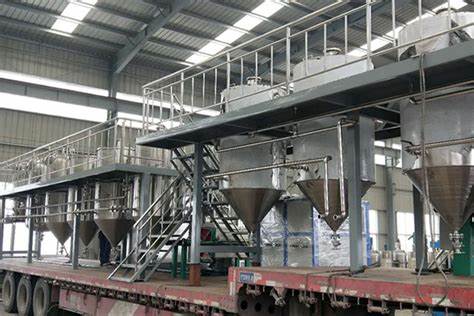The crude flax seed oil squeezed out by the oil press contains free fatty acids, phospholipids, pigments, mucilage and other substances, all of which affect the quality of flax seed oil, which must be refined to meet product quality standards. The refining of coarse flax seeds requires equipment such as refining tanks, washing tanks, vacuum dehydration tanks and filter presses.
The refined flax seed oil should have a moisture content of 0.07% or less, an acid value of 0.4mgKOH/g or less, an iodine value of 177--195gI/100g, a relative density of 0.9320--0.9380, and a refractive index of 1.4790--1.4810 , The saponification price is 189-195mgKOH/g, the heating test meets the national standard, and the refining rate is less than 96%.

The specific operation method of flax seed oil refining:
1. Fast delivery of flax seed oil Before the filtered crude oil is pumped into the refining tank, check whether the pipeline valve is normal. After each tank has finished sending the oil, the oil inlet valve should be closed immediately. For the crude flax seed oil to be refined in the oil tank, the oil surface foam must be removed to make the oil surface smooth, and it should be allowed to stand for an appropriate period of time (not less than 15 minutes) so that there is no foam in the oil. Adjust the crude oil temperature to 25-35°C.
2. Preparation of lye: Weigh out the prescribed amount of NaOH (purity must be identified first), mix it with an appropriate amount of water and stir, start the alkali pump, and circulate the lye to completely dissolve the NaOH. Reduce the temperature of the lye to 25-30°C, let it stand for 20 minutes, measure the Baume degree of the lye with a Baume meter, and adjust it to 10--12°Be.
3. When the oil surface of the crude oil is smoothed and the temperature is stable at 25-35℃, start the stirrer to start stirring, firstly rotate slowly (20r/min) and stir for 1min, then change to fast speed (40r/min), while stirring, Open the alkali tank valve and put in the alkali solution. The time for adding lye is generally about 15 minutes. After the lye is put in, continue to stir quickly until the oil and soap particles are clearly separated. The stirring time is about 3-3.5h. When the oil and soap feet are clearly separated, change to slow stirring, open the heating steam door (vapor pressure 1.4kgf/C), and increase the temperature of the oil to 60°C (the oil temperature rise should be maintained at 1°C/min, high temperature Do not exceed 65°C) Stop stirring immediately, close the steam valve to cool and precipitate by itself (precipitation time is about 8h). After checking that the oil delivery valve pipeline is normal, pump the oil into the washing tank. When pumping to the interface between the oil and the precipitated soap feet, be careful not to pump out the soap feet and at the same time pump out the oil.
4. Water washing Heat up the oil pumped into the washing tank, and at the same time start the stirrer to add 75-80℃ hot water to keep the oil temperature at 80-85℃ (the temperature must not exceed 85℃). When the water is added (the amount of water added is 15%-20% of the oil, and the time of adding water is 38-40min), stop heating and continue stirring for 15 minutes, that is, stop stirring, settling for 2h (one time), and wash the drain at the bottom of the tank. The valve is opened, and about 3/4 of the washing water is released (first put the oil in the pipeline into the oil-water separation tank before releasing the washing water). Then close the drain valve, open the valve leading to the oil-water separation tank, and slowly put in the remaining oil-water mixture. When washing with water, put all the viscous material in the middle layer of oil and water into the separation tank until the oil is good, and then close the valve.
The separation of oil and water must be controlled by a special person. When separating in the separation tank, the heating coil in the tank must be turned on, the temperature must be increased (not allowed to exceed 80°C), and the water will be released after separation to recover the residual oil.

Follow the above method to continue washing the oil machine with water until the washing water is completely clear, and the sedimentation time of the second washing is 1.5h.
5. Before the dehydration and transportation, check whether the relevant pipeline valves are normal, and then pump the oil of the washing guest into the vacuum dehydration tank. At the same time, open the steam valve, turn on the vacuum pump and agitator, adjust the cooling water of the condenser, and turn on the circulating oil pump to accelerate the vacuum. Circulation of oil in the dehydration tank. The vacuum degree of the vacuum dehydration tank is kept above 0.0867MPa. The dehydration time is about 3 hours, counting from the oil delivery in the dehydration tank, and the dehydrated oil should be sampled and inspected by the quality inspector. When it is found that the dehydration is insufficient, the dehydration must be continued. The dehydration temperature is maintained at about 70°C.
After dehydration is complete, stop the vacuum pump, open the air valve, and slowly add air. Check whether the pipeline valve is normal, and then the conveyed oil is cooled to 25--30℃ through the cooling pipe and flows into the sedimentation tank for pressure filtration.
6. Filter press Check whether the valve of the filter press pipeline is normal. Check that the oil temperature must be below 30°C. After the oil is filtered, stop the oil filter pump to close the valve, gently open the filter plate to allow the internal oil to flow into the oil pan, and then remove the filter residue on the filter cloth. Check the usage of the filter cloth and prepare to be replaced or washed. The residual oil of the filter cloth should be separated and recovered by a centrifuge.
7. Residual oil recovery Use the oil-water separation tank to separate the recovered oil and re-refine it. The filter cloth with residual oil is folded neatly and evenly, put into the centrifuge, and after separation, the residual oil is recovered for refining. When operating the centrifuge, you must strictly control the speed of the centrifuge, and gradually increase from slow to fast when starting. If it is necessary to stop in the middle of the rotation, the motor should be stopped, but when the centrifuge is not completely stationary, it is not allowed to close and continue to start.

The amount of caustic soda added and the concentration of the lye depends on the acid value and impurity content of the filtered crude flax seed oil. If the acid value is high, the amount of alkali needed to neutralize the free fatty acid should be more, the concentration should be higher, the acid value should be low, the amount of alkali should be less, and the concentration should be lower. When there are many impurities, the amount of super-alkali will be more. According to the impurity content of flax seed oil, the amount of super alkali added is generally 0.1%-0.2%. However, the ingredients collected in crude oil are complicated. For example, the acid value and impurities determine the amount of alkali used and the concentration of lye. Sometimes it may not necessarily achieve good results. Therefore, a small cup test is performed before refining. The temperature of alkali addition must not be too high. After adding alkali to neutralize the oil, the temperature of the oil is increased to destroy its emulsified state, so that the soap particles are completely separated from the oil. The stirring speed should be fast when adding alkali to neutralize. The purpose is to make the lye and the oil fully contact, so that the free fatty acids in the oil can be quickly neutralized. After the free fatty acids are completely neutralized, the stirring should be slow during the heating period to prevent formation The soap noodles are broken into small ones that are difficult to sink. Then wash with water to remove trace soap particles and free alkali dissolved in the oil. After linseed oil is washed with water, it has a high water content (0.3%), and it is easy to change the quality during storage, so it must be dehydrated. One process of refining is cold-cold filtration to remove waxy substances contained in the oil.
If you want to know more about the processing technology of flax oil, please feel free to contact us!
Copyright © Henan Zhongxing Grain And Oil Machinery Co.,Ltd. All Rights Reserved. Powered by MetInfo